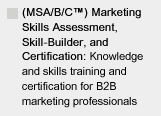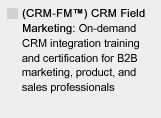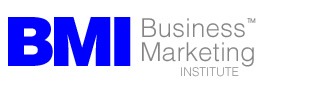MAKE SURE YOU CONTINUE TO RECEIVE EACH ISSUE OF TUESDAY MARKETING NOTES—CLICK HERE TO RENEW YOUR FREE SUBSCRIPTION (IF YOU'VE ALREADY SUBSCRIBED, NO NEED TO RE-SUBSCRIBE)

Building Marketing Programs Around
Your Content: What Do Ads Look Like in the
Post-Marketing Era? (Part 4)
Build Your Marketing Around Your Content
by Eric Gagnon
In last week’s TMN (and previous issues, Part 1 and Part 2), we’ve described the importance of content in the post-marketing era, and covered in detail the process of developing effective content used as the basis for creating marketing programs that generate measurable sales response.
What Do Ads and Other Marketing Deliverables Look Like in the
Post-Marketing Era?
What does an ad look like in a content-based marketing program? Is print advertising dead? Are conventional marketing media, such as trade publication advertising, direct mail, etc. still a viable part of a post-marketing lead generation program? Yes, conventional marketing media plays an important, but quite different, role, and ads and other deliverables used in this media are also radically different.
Developing content-based marketing programs is a new type of B2B marketing, where you are using your offline media—print ads, mailings, trade shows, etc.—to link potential prospects to your content, using the Internet and social media. In our new post-marketing era, conventional, “offline” marketing media, like print advertising and direct mail, is used mainly to link your audience to the content you create, and to draw these readers and viewers into a dialogue with your sales team, that, supported by your ongoing lead development program, leads to opportunities to sell your product.
This new way of B2B marketing also requires a new approach to developing the ads and other physical deliverables in your marketing program, emphasizing the features and benefits of your content, not the shopworn marketing-speak that’s already being ignored by your audience.
Build Your Marketing Programs Around Your Content
Until now, marketers using content in their B2B marketing programs have been building the content around their marketing: For example, as marketing professionals, we develop a conventional, product benefits-oriented ad, and although we plug an offer for the free white paper in the call-to-action area of our layout, the ad uses product-focused benefit copy to motivate readers to action. However, content-based marketing programs are very different: The marketing program is built around the content, and the deliverable—the ad, mailing piece, Web page, etc.—describes and sells the content, not necessarily your company’s product.
What are we selling here—the content, or the product? You’re using your deliverables to sell your content, but the downstream product sales benefits are both immediate and measurable. If your content truly serves your market, your content-based marketing programs meet your product sales goals by providing you with measurable sales response from the readers who access your content, and the engagement this content brings to your marketing effort in the ongoing conversations that happen between prospects and your sales team, as these prospects become buyers in your sales process.
Content-based marketing programs turn conventional B2B marketing upside down, humanizing the process of lead generation by providing readers and viewers with the hype-free content that adds value to their decision-making process involving products like yours, and pointing them to the solutions to their problems available from your company, through your content.
By addressing a major concern or issue involving your product’s field of use, content-based marketing programs provide you with the added benefit of uniquely positioning your company and product in ads and other deliverables, using presentation not ordinarily seen in conventional marketing programs. This is quite a revolutionary approach to B2B marketing, because it places plain facts and reason above emotional appeal, gimmicks, or clever positioning.
Having Great Content Makes It Easy to Develop Great Content-Based Marketing Programs
Of course, the first step in developing an effective content-based marketing program is to produce interesting and useful content. Once you do this, the process of developing effective presentation of this content in marketing deliverables is much easier, because the copy and presentation you develop reflects this quality of this content in the ads, landing pages, and other deliverables that drive prospects to this content.
Here are some ideas and examples to help you develop content-based marketing programs . . .
Make the major premise of the content the main feature of copy you’re using in your ad, mailing, or other deliverable. This is easier to do, for example, if you’re already using a punchy, compelling headline in your content deliverable, such as this white paper for a company selling pre-employment background screening services to HR professionals and hiring managers:
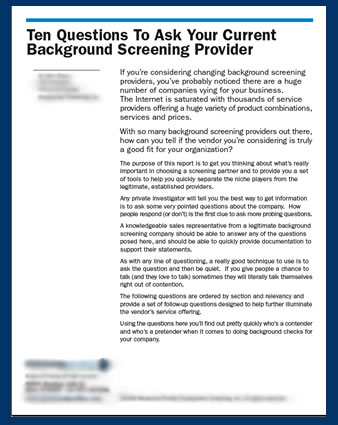
Write like an editor, not a copywriter: Plain, fact-based presentation is always best for writing content-based deliverables. Think like an editor when writing a headline and summary teaser paragraph for an article (or, maybe just to add a little hype) as an editor writing these bullet points for the cover of a magazine.
Body copy also reflects this minimum-hype approach: Describe one, two, or three key advantages of your white paper, report, or other content, and point readers to where they can find it online.
For example, here’s an ad for the previous white paper:
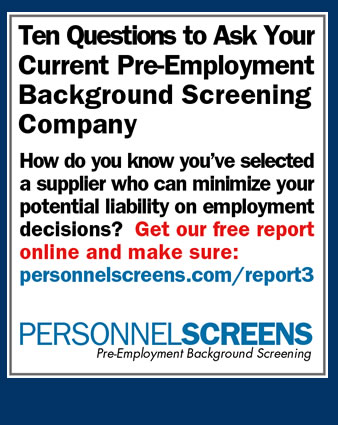
Notice how by simply describing the content, providing a key detail or two about the content, and showing the reader where to get the report we don’t have to push sales benefits in the copy—the content speaks for itself, even in this small, quarter-page fractional ad space.
The more content you have, the more opportunities you have to promote it: Better still, because we’ve developed three reports of value, instead of running a full-page ad, we can place three small, quarter-page ads throughout the same publication issue to highlight each report:
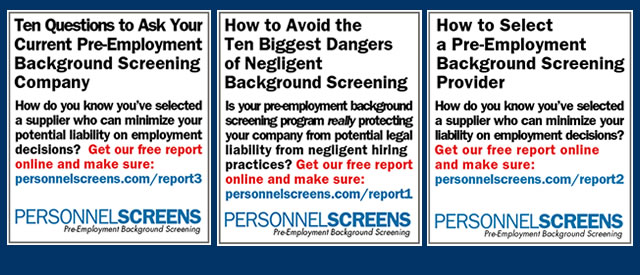
–now we get the benefit of increased exposure throughout the publication, reinforcing three content-focused messages instead of one, and we can test and measure responses from each ad, to track which of these reports draws the best response.
Ads for Content-Based Marketing Programs Don’t Have to
Look Like Ads
The other exciting aspect of content-based ads and deliverables is they don’t have to look like conventional display advertising. In fact, the less your content-based ads look like conventional display ads, the more effective they probably are. To prove this point, and to show that content-based ads are nothing new, here are a few examples of highly-successful editorial-based trade ads from the 50s, 60s, and 70s:
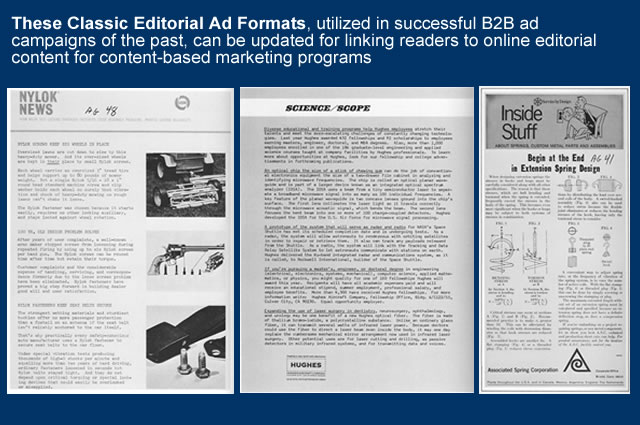
These ads (larger versions available at this link), referenced by Fred Poppe in his book The 100 Greatest Corporate and Industrial Ads, were each from highly successful, response-generating campaigns that ran for many years, attracting technically-oriented prospects in search of answers to their problems and product applications.
Formats such as these, with a little updating, can work beautifully today in print ads or mailing pieces to display brief teaser paragraphs for your content, with “jumps” to the full, downloadable versions on your Web site.
Content-Based Marketing Programs Make Your Voice Heard in B2B Markets
Because they don’t look like all of the other ads around them, and because they impart information, not product hype, your content-based ads and deliverables give you a clear, unique, problem-solving voice that’s heard by your prospects above the usual white noise of most B2B marketing.
They also provide your company with the benefit of uniquely positioning it away from its competitors, through your company’s intent to show prospects how to solve the problems that are important to them, instead of repeating the same hackneyed marketing copy that’s only important to your company or your client.
Social media is all the rage these days, but among B2B marketers it’s still mostly talk. In the post-marketing era, as online media eclipses traditional marketing media, social media will play an important role as a vehicle for pointing prospects in your market to the content at the center of your content-based marketing programs. Next week, we’ll look at scenarios for executing content-based marketing programs, including social media . . .
Eric Gagnon (eric@realmarkets.net), a director with the Business Marketing Institute, is author of The Marketing Manager’s Handbook and The CRM Field Marketing Handbook, and president of GAA ( http://www.realmarkets.net ), an interactive marketing, turnaround, and product development consulting firm.


